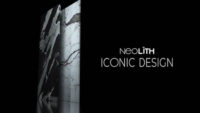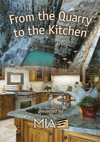Working with top grade exotic materials to create custom stone surfaces requires the utmost skill and precision. Clients expect professionalism and a fast turnaround; mistakes carry a high cost in materials and time. “Part of our high-end service, along with the quality, is that everything has to be done yesterday,” explained Nick Patrona, who, along with his father David and his brother Chris, owns and operates Patrona Marble and Granite, a high-end marble and granite stone company based in South Florida. The company produces both simple and complex stonework for kitchens, baths, stairways and other installations, and much of its work involves radius edges and custom shapes.
Patrona believes that going digital is the key in today’s market to providing the best finished product with the fastest completion time, and he is always on the hunt for the best in technology. “It is all about turnaround time,” he said. “It’s very important for us to be able to get something complicated measured as efficiently as possible and then manufactured as efficiently as possible as well.”
The company purchased a CNC router in 2008, and by 2013, it was using two CNC machines along with a new state-of-the-art Omag 5-axis saw on the router. Now using mostly CAD software in its manufacturing process, the origin of those files had to be addressed. Templating had become the least efficient part of the process. “I looked at all major brands offering digital template options,” said Patrona, of his quest to speed up template times and stop using luan sticks. “The Leica 3D Disto, although new in our industry at the time, stood out to me as the best answer to what I was looking for in a digital template device.”
A digital templating alternative
When Patrona first became aware of 3D digital templating technology as it was just coming out on the market, he immediately saw how it could benefit his business. “I am not the kind of person to just buy something,” he said. “I research it and really make sure it is what we want for our needs.”
Patrona’s first concern was accuracy and the ability of a laser measurement system to capture the complex shapes and surfaces that Patrona Marble and Granite regularly produces for its clients. Some lasers he looked at were on a fixed level, which would create issues when they needed to shoot on an angle. Rather than being fixed, the 3D Disto system’s head has the ability to pivot so that angles can be captured accurately. The three-dimensional capabilities also captured his attention: 3D would be essential for measuring walls and anything vertical, like the custom showers, backsplashes and staircases his company frequently creates.
“The motorized head and camera on the laser point is something that really makes this system great,” said Patrona. “I am often 15 feet away from the unit, holding a target on a different plane, and I can see my target and shoot it remotely with the tablet. It is so practical to see not just the dot, but a video of where the laser is.”
The 3D Disto also advertised the ability to measure curved surfaces, skewed walls and inaccessible areas — benefits the Patronas found very appealing.
Verifying measurement accuracy and performance
When they first purchased the 3D Disto, Patrona set it up with his CAD software on his laptop and took it to work. “I was able to start using it right away without any problems,” he said. The way the laser plotted points was intuitive and familiar; the 3D Disto created the same kind of file Patrona used when he plotted wood templates into his CNC. Patrona also enjoyed using the touchscreen tablet to control the laser.
Concerned above all about continuing to produce the most accurate products for their clients, he spent the first three jobs measuring and re-measuring to make sure he was getting the right numbers. “I was double checking like a maniac,” he said, adding that each time, the measurements were perfect. “After that, I just let it go, and I’ve not had any problems.”
One of the popular products Patrona Marble and Granite creates for its customers in South Florida is a granite outdoor kitchen. This means it necessarily does a lot of its work outside in the sunlight. Patrona had heard that some lasers have problems on reflective surfaces, and he was concerned that the bright Florida sunlight and the reflective surfaces of the exotic stone materials they work with would cause problems for the laser. After nearly a year of using the 3D Disto, he has been pleased with its reliable performance. “We’ve shot so much in the sun, on various surfaces, and not had one single problem under the harshest Florida sun conditions,” he said.
“The more complicated the project, the better”
According to Patrona, the real time savings from using 3D digital templating technology comes when working on more complicated projects. In fact, “the more complicated the project, the more time it will save,” he said. He mentioned two tub decks that he finished in a single day that required a lot of technical work because of all the radiuses. “I was in and out of there in about 40 minutes for each one, and one of them was almost completed at the end of the same day,” he said. “That would never happen with sticks.”
Patrona has discovered that he can bring his laptop to jobsites and do all his CAD work in the field rather than creating the templates and going back to the office. “I like to do that cleanup on the jobsite while I’m there in case there is a change, and I can verify it physically,” explained Patrona. “Now there’s nothing stopping me from emailing those files directly to the shop from the jobsite.”
Less programming time in the office frees up time to do significantly more work. By Patrona’s estimate, he is saving around 20 hours of working time over the course of each month. That equates to more than two whole days’ worth of extra work he is able to complete because of the 3D Disto — or about six extra weeks of work per year.
Now that the company’s templating process is all digital, Patrona has discovered an unexpected benefit. Since he no longer carries around the stick templates to jobsites, he doesn’t need the big truck he was using to haul templating equipment, supplies and the finished templates. Instead, he now drives a small SUV that gets 28 miles to the gallon, which has created a significant savings in fuel. “When I had my truck, I spent $400 to $600 a month in gas,” he said. “I am now spending $200 to $300 — that’s half.”













